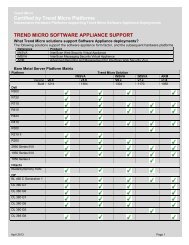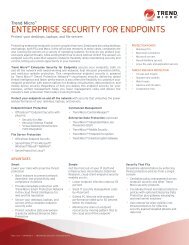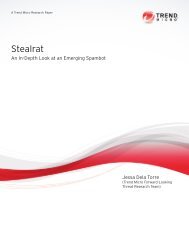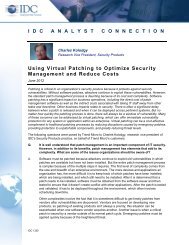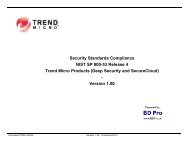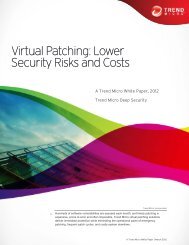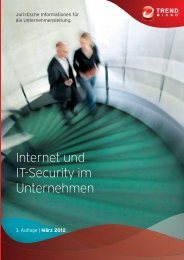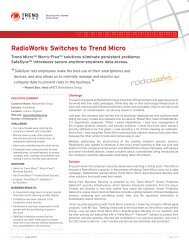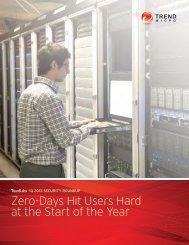Virtual Patching: a Proven Cost Savings Strategy - Trend Micro
Virtual Patching: a Proven Cost Savings Strategy - Trend Micro
Virtual Patching: a Proven Cost Savings Strategy - Trend Micro
Create successful ePaper yourself
Turn your PDF publications into a flip-book with our unique Google optimized e-Paper software.
<strong>Virtual</strong> <strong>Patching</strong>: a <strong>Proven</strong><br />
<strong>Cost</strong> <strong>Savings</strong> <strong>Strategy</strong><br />
An Ogren Group Special Report<br />
December 2011
Executive Summary<br />
Security executives, pushing the limits of traditional labor-intensive IT patch processes that<br />
cannot close vulnerabilities fast enough, are turning to virtual patching to protect servers and<br />
desktops against new cyber threats. <strong>Virtual</strong> patching offers a proven strategy – delivering timely<br />
protection within hours of vulnerability publication – weeks or months ahead of the traditional<br />
patch. In addition, security executives leveraging a virtual patching strategy are achieving<br />
compelling cost savings by reducing the frequency of patch and software maintenance cycles.<br />
The traditional method of applying permanent software patches and upgrades is much too<br />
labor-intensive and invasive to applications to compete with the speed of exploits. Exploits<br />
appear in the wild only a day after announcement of a vulnerability; most damage from<br />
automated attacks occurs within the first 15 days of the news and 80% of exploits appear within<br />
60 days. Even with a concentrated effort in maintaining compliant server and desktop<br />
configurations, the average organization still takes over 30 days to patch standard operating<br />
systems and applications, and months or years to patch complex business applications.<br />
<strong>Virtual</strong> patching inspects and cleans network traffic using host-based filters to efficiently<br />
correct or block application input streams that might otherwise exploit vulnerabilities, before<br />
the malware even reaches the vulnerable target and without disruption to applications and<br />
business operations. The Ogren Group finds that organizations integrating virtual patching into<br />
vulnerability management processes are realizing compelling cost savings:<br />
<br />
<br />
<br />
<br />
Helps ward off disclosure incidents by rapidly neutralizing critical vulnerabilities in<br />
servers and desktops. <strong>Virtual</strong> patching acts to prevent exploits of known vulnerabilities<br />
within hours of announcement.<br />
Allows orderly patch maintenance based on IT schedules. Security teams research, test,<br />
and deploy traditional patches in a controlled manner with fewer panic patch incidents.<br />
IT can save resources by lengthening the interval between standard patching cycles.<br />
Postpones upgrade costs by extending the life of legacy systems. Many organizations<br />
have legacy applications or operating systems that are no longer supported with patches<br />
or upgrades. <strong>Virtual</strong> patching allows IT to extend the life of legacy applications,<br />
postponing the costs of re-engineering or upgrade.<br />
Enables cost effective security for virtualized environments. Organizations are<br />
embracing virtualized applications for proven cost savings and enhanced security.<br />
<strong>Virtual</strong> patching, residing on the server or within each VM, protects virtualized<br />
environments from exploits of vulnerabilities discovered after creation of the VMs.<br />
This special report, commissioned by <strong>Trend</strong> <strong>Micro</strong>, reinforces the security and operational cost<br />
savings of host-based virtual patching with the Deep Security and OfficeScan products.<br />
Information in this report derives from Ogren Group research and interviews with enterprise<br />
security officers of global organizations.
<strong>Virtual</strong> <strong>Patching</strong><br />
<strong>Virtual</strong> patching is a host-based security capability that shields applications and endpoints from<br />
vulnerabilities until permanent corrections from procedures such as patch management and<br />
software maintenance can be applied. Instead of modifying executable programs, with resultant<br />
complexities in quality assurance and software asset management, virtual patching operates on<br />
network streams, inspecting inbound traffic and shielding applications from exploits, even<br />
though the vulnerability has not been permanently patched. The enhancements to an<br />
organization’s patch process that virtual patching delivers significantly lessen the workload<br />
throughout the entire patch process:<br />
<br />
<br />
<br />
Applies easily in the network data path without change to the application or desktop<br />
environment. <strong>Virtual</strong> patching does not require modification of the application or<br />
operating system, reducing the overhead burden of testing and deploying patches, and<br />
sometimes recovering from bad patches.<br />
Reduces the incentive to use network firewall and router rules to avoid patches. Many<br />
security teams look to adjust firewall or router rules in order to avoid applying software<br />
patches, which may unnecessarily block legitimate traffic to other applications and can<br />
lead to undesirable maintenance side-effects in the network.<br />
Sustains production applications for better uptime and SLA performance. Critical<br />
applications can be shielded from vulnerabilities with virtual patching without<br />
scheduling off-hours downtime.<br />
<strong>Virtual</strong> patching accelerates the time to patch for continuous compliance of key applications and<br />
endpoints. Security and IT teams reduce operating costs by requiring fewer software patch<br />
cycles and software maintenance fixes. In addition, virtual patching is the only pragmatic<br />
method of shielding legacy applications where patching becomes unappealing due to high<br />
engineering costs or risk of extended downtime.<br />
React quickly to new vulnerabilities<br />
One of the most compelling and widely used metrics in security is the elapsed time from the<br />
vendor’s announcement of a vulnerability until IT has deployed the patch in affected systems.<br />
While security teams cannot control when exploits arrive through the network, IT can control<br />
how long an attacker has to exploit an un-patched vulnerability within the corporate<br />
infrastructure. In many cases, it can take 30 days or more to research, test, and deploy a patch<br />
to operating systems and often longer for applications. <strong>Virtual</strong> patching shrinks that<br />
vulnerability exposure for servers and desktops by automatically delivering a patch within days<br />
and most often within hours. The cost savings of virtual patching are being proven by enterprise<br />
security teams:<br />
<br />
Reduce the risk of an exploited vulnerability requiring public disclosure of regulated<br />
data loss. Since the vulnerability exposure is quickly mitigated, the risk of losing<br />
regulated data and incurring costly public disclosure expenses is significantly reduced.
Reduce the need for ad-hoc emergency patching or software corrections. <strong>Virtual</strong><br />
patching buys time for IT to schedule permanent patches and software corrections in an<br />
orderly fashion. Less resource is expended on emergency application of high priority<br />
patches or quick engineering corrections to the source code.<br />
Service level agreements and application uptime are enhanced. <strong>Virtual</strong> patching<br />
automatically secures application and desktop environments by patching vulnerabilities<br />
without application downtime.<br />
Extend the life of legacy applications and platforms<br />
Many organizations have mission critical applications that execute on operating system<br />
platforms that are no longer supported by the OS vendor or are considered to be too fragile to<br />
patch. Legacy applications may not be easily upgraded to newer OS versions due to lack of<br />
engineering priority on newer revenue generating applications, risk of extended downtime of<br />
the application, or prohibitive costs of rebuilding an application that has been previously<br />
expensed. <strong>Virtual</strong> patching gives IT an alternative to extend the life of applications on legacy OS<br />
platforms by reducing compliance, security, and operational costs issues for the business.<br />
<br />
<br />
<br />
<br />
<strong>Virtual</strong> patching may obviate the need for expensive support contracts for legacy<br />
operating systems. For instance, support contracts for Windows 2000 start at $50,000<br />
per quarter and Oracle has instituted a pay-per-patch plan for Solaris 8.<br />
Postpone application replacement expenses. <strong>Virtual</strong> patches can prolong the life of<br />
applications based on unsupported operating systems – postponing new investments in<br />
servers, operating system licenses, and application software upgrades.<br />
IT can protect in house-developed applications with custom virtual patches It is easier to<br />
deploy a virtual patch in the network data stream than it is to re-engineer application<br />
software. <strong>Virtual</strong> patching allows organizations to save engineering expenses by applying<br />
custom developed virtual patches for legacy applications.<br />
<strong>Virtual</strong> patching may be the only pragmatic way to shield legacy application<br />
vulnerabilities. Legacy applications or production systems, such as those based on<br />
Oracle databases, may be too sensitive for invasive software patches, but can be further<br />
protected from exploits with virtual patching.
<strong>Trend</strong> <strong>Micro</strong> virtual patching<br />
<strong>Trend</strong> <strong>Micro</strong>’s flagship security solutions for servers and end-user endpoints, respectively Deep<br />
Security and OfficeScan deliver timely virtual patching within enterprise networks. <strong>Trend</strong><br />
<strong>Micro</strong>’s virtual patching solution saves IT time and effort throughout the patch process, from<br />
notification of available patches, identification of affected applications, and minimization of the<br />
points where virtual patches need to be applied:<br />
<br />
<br />
<br />
Consolidates notifications of announced vulnerabilities and available virtual patches.<br />
<strong>Trend</strong> <strong>Micro</strong> virtual patching leverages relationships with critical infrastructure software<br />
vendors and industry organizations such as CERT, SANS, Bugtraq, VulnWatch,<br />
PacketStorm, and Securiteam to keep security teams continually informed of<br />
vulnerability shield and patch availability.<br />
Automatically discovers applications and vulnerabilities. <strong>Trend</strong> <strong>Micro</strong> virtual patching<br />
detects the presence of applications and evaluates the applications for vulnerabilities to<br />
make prioritized recommendations for IT.<br />
A single virtual patching instance shields multiple virtual machines. For virtualized data<br />
center applications, <strong>Trend</strong> <strong>Micro</strong> virtual patching, deployed as a single virtual appliance,<br />
saves IT time and effort by automatically shielding application vulnerabilities all across<br />
the virtual machines on the server. Alternatively, virtual patching can be executed and<br />
managed on a per VM basis.<br />
<strong>Trend</strong> <strong>Micro</strong> delivers complete virtual patching coverage to organizations for servers and<br />
endpoints as a module within the Deep Security product as well as an Intrusion Defense<br />
Firewall plug-in for the OfficeScan endpoint protection product. Enterprise security teams are<br />
thus able to deploy virtual patching to servers and desktops across the organization with<br />
consistent administration and reporting interfaces.<br />
Deep Security provides software-based integrated security for systems operating in standalone,<br />
virtual, and cloud-based environments with a single, centrally managed solution that includes:<br />
<br />
<br />
<br />
<br />
<br />
Deep packet inspection (IDS/IPS, Web Application Protection and Application Control)<br />
Anti-malware<br />
Bi-directional stateful firewall<br />
Integrity monitoring<br />
Log inspection<br />
OfficeScan users in enterprise environments receive virtual patching benefits with the Intrusion<br />
Defense Firewall plug-in, proving an easy to administer solution that includes:<br />
<br />
<br />
<br />
<strong>Virtual</strong> patching for operating systems and certain common applications<br />
Acceptable-use security policies that can block traffic from specific applications, such as<br />
those from social media sites<br />
Firewall protection for remote and mobile enterprise endpoints
Removal of infected data from network traffic<br />
Automatic adjustments of security configuration based on an endpoint’s location<br />
Centralized administration and reporting<br />
The Ogren Group research also finds that not only are organizations integrating <strong>Trend</strong> <strong>Micro</strong>’s<br />
virtual patching into security processes, but that those security processes are also evolving to<br />
take advantage of virtual patching cost savings benefits. The maturity of virtual patching and the<br />
proven cost savings for IT has allowed security teams to address significant enhancements to<br />
protecting the business, including:<br />
<br />
<br />
<br />
Integration with vulnerability management processes to automate protection.<br />
Automation is the key to driving more costs out of maintaining compliant servers and<br />
desktops. <strong>Trend</strong> <strong>Micro</strong> has integrated virtual patching with leading vulnerability<br />
management vendors to automate the discovery, assessment, and protection of servers<br />
and desktops.<br />
Integration with virtualization processes to efficiently protect virtualized applications<br />
and virtual desktop infrastructures. <strong>Trend</strong> <strong>Micro</strong>’s innovative approach of utilizing a<br />
single anti-malware virtual appliance on a server that also contains virtual patching<br />
software has been deployed by large enterprises. The <strong>Trend</strong> <strong>Micro</strong> virtual appliance<br />
requires no agents to be bundled into each virtual machine, enhancing performance,<br />
preserving VM densities, and automatically protecting VMs that cannot otherwise be<br />
easily patched.<br />
Integration with cloud-based security systems to cost effectively protect servers and<br />
desktops. <strong>Trend</strong> <strong>Micro</strong> utilizes its Smart Protection Network to efficiently feed the latest<br />
virtual patches to Deep Security and OfficeScan.
Conclusions and recommendations<br />
IT organizations are evolving their infrastructure to reduce operating costs, efficiently meet<br />
compliance mandates, and flexibly deliver new services to the business. The Ogren Group<br />
believes that virtual patching with <strong>Trend</strong> <strong>Micro</strong>’s Deep Security and OfficeScan is proving to be a<br />
compelling example of a cost savings strategy that carries significant security benefits:<br />
<br />
<br />
<br />
<br />
React quickly to mitigate the exposure of new vulnerabilities for critical servers and<br />
desktops. <strong>Virtual</strong> patching delivers timely vulnerability protection without application<br />
modification, reducing the time required to test and deploy critical patches.<br />
Allows orderly patch maintenance based on less frequent IT schedules. Security teams<br />
research, test, and deploy traditional patches in a controlled manner with fewer patch<br />
deployment cycles.<br />
Extend the life of legacy applications. <strong>Virtual</strong> patching can remove vulnerabilities from<br />
expensed applications on older operating systems such as Windows 2000 and Solaris 8,<br />
avoiding expensive support contracts.<br />
Reduce business disruptions and costs associated with emergency patch and software<br />
fix operations. <strong>Virtual</strong> patches, delivered automatically from <strong>Trend</strong> <strong>Micro</strong> allow IT to<br />
patch and correct software for high priority vulnerabilities on planned work schedules.<br />
The Ogren Group recommends that enterprises take advantage of the proven cost savings of<br />
virtual patching. In particular, virtual patching services can save IT time and money while<br />
enhancing the security of data center applications. The Ogren Group believes <strong>Trend</strong> <strong>Micro</strong>’s<br />
virtual patching, delivered through Deep Security and OfficeScan agents, should be on the<br />
shortlist of security teams requiring quicker vulnerability shielding and patching coverage to<br />
ensure a secure and compliant business.
<strong>Virtual</strong> patching cost savings worksheet<br />
Utilizing virtual patching reduces your security risks while reducing operating costs. Individual<br />
expected cost savings will vary by organization based on the strategies chosen. Use this<br />
worksheet to help itemize the cost savings of virtual patching in your organization.<br />
Optimize the operational efficiency of the patch process<br />
The number one job of virtual patching security is to protect the business from malicious code<br />
and theft of regulated data and intellectual property. <strong>Virtual</strong> patching filters are deployed in<br />
hours, protecting applications until permanent patches or software fixes can be applied.<br />
$______<br />
$______<br />
$______<br />
$______<br />
$______<br />
$______<br />
$______<br />
$______<br />
$______<br />
Reduce the annual cost of<br />
emergency out-of-band patches<br />
Reduce the annual cost of<br />
emergency software fixes<br />
Reduce the frequency of standard<br />
patching cycles<br />
Enhanced application uptime<br />
savings<br />
Reduce the risk of disclosure<br />
incidents<br />
Reduce the costs of patch rollbacks<br />
Reduce the costs of discovering<br />
available patches<br />
Reduce the patch applicability<br />
research effort<br />
Protect “untouchable”<br />
applications<br />
Factor in time required to test and apply<br />
patches given a weighted cost of IT labor.<br />
For certain applications this includes<br />
outsourcing fees or in-house charge-backs.<br />
With the protection of virtual patching you<br />
may be able to extend the interval between<br />
standard patching cycles, freeing IT to focus<br />
on other activities and reducing downtime<br />
Applications remain operational with virtual<br />
patching, resulting in extra hours of uptime<br />
that can be reflected in revenue or improved<br />
SLAs.<br />
Shrinking the window of vulnerability<br />
translates into a lower probability of<br />
regulated data loss and withholdings for<br />
disclosure incidents.<br />
Patches are invasive to applications and<br />
operating systems. It is not uncommon for a<br />
patch to break a system in production use<br />
and have to be removed.<br />
Deep Security virtual patching automates<br />
monitoring of vendor advisories and<br />
vulnerability sources including CERT, SANS,<br />
Bugtraq, and VulnWatch to provide IT with<br />
comprehensive notifications of patches.<br />
Deep Security virtual patching automatically<br />
recognizes applications and their patch<br />
levels. Also, virtual patching lessens the<br />
incentive to deploy patch work-arounds in<br />
firewall and router rules.<br />
Applications may be considered un-patchable<br />
because of cost or the risk of down-time –<br />
e.g. Oracle database servers.
Extend the life of legacy platforms and applications<br />
Legacy applications, especially those running on Windows 2000, Oracle 10.1, Red Hat 3, and<br />
Solaris 8 operating systems, are expensive to keep compliant. <strong>Virtual</strong> patching allows the ROI of<br />
legacy applications to improve as the lifetime is extended.<br />
$______<br />
$______<br />
$______<br />
Reduce the annual cost of legacy<br />
platform support contracts<br />
Reduce the costs of migrating<br />
legacy applications<br />
Reduce sustaining engineering<br />
expenses for legacy applications<br />
Vendors may charge per patch, or require<br />
expense relief for supporting retired<br />
software.<br />
Extending the life of an application postpones<br />
investments in servers, platform software,<br />
and application engineering.<br />
Applications remain operational with virtual<br />
patching, allowing IT to postpone permanent<br />
software corrections<br />
IT initiatives such as virtual data centers, virtual desktop infrastructures and protection of<br />
cloud-oriented application systems are strategic decisions, with longer term cost savings<br />
benefits. <strong>Trend</strong> <strong>Micro</strong>’s Deep Security and OfficeScan virtual patching has direct cost savings for<br />
quickly limiting the exposure to new vulnerabilities and extending the life of legacy applications.<br />
This worksheet will help IT analyze the impact of virtual patching for their organization.





